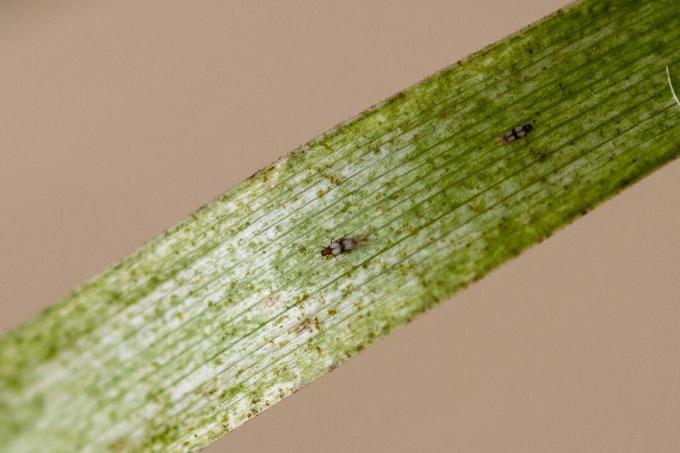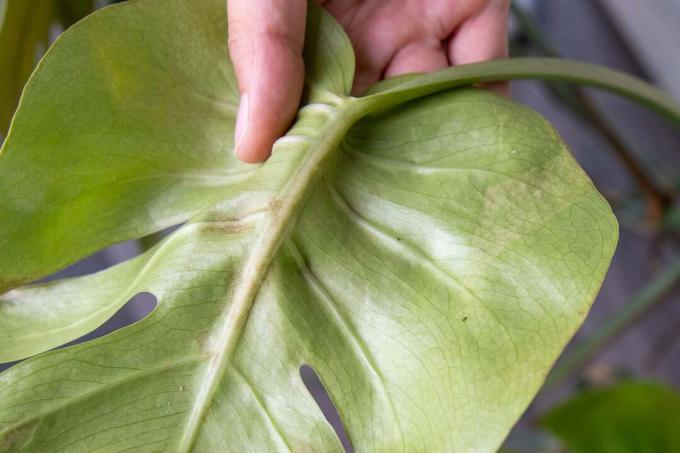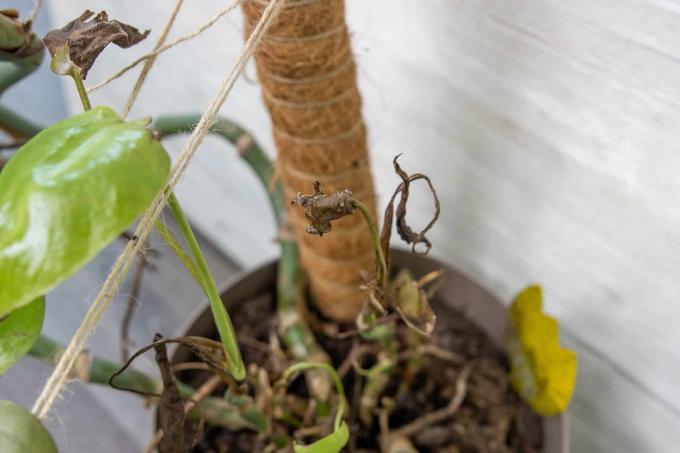
The thrips are a pest that can hardly be seen with the naked eye. Houseplants are usually attacked by the sucking insects, making them severely weakened and more susceptible to disease.
To the point
- maximum 3 mm long
- Leaves turn yellowish and brown
- Plant significantly weakened
- Leaf deformations
- Secondary illnesses such as fungal or viral infections are possible
Table of contents
- Look
- damage pattern
- Consequential damage
- Affected plants
- Cucumber test
- frequently asked Questions
Look
The thrips are also known as thrips because they have hair fibers on the edges of their wings. The insect is only a few millimeters long, which is why an infestation remains hidden for a long time. Only when significant damage has occurred will a closer look be taken. Only under a magnifying glass can the extent of the damage be seen.

Characteristics:
- 1 – 3 mm long
- fringed wings (dropped by females for mating)
- Larvae translucent light green
- Adults dark brown to black
The thrips are able to fly and can travel up to 10 cm per second. If there is an infestation, always check the surrounding pots.
damage pattern
A sign of an infestation is plants that quickly become weaker.

Other signs:
- yellowish leaves
- clearly visible leaf veins
- brown spots
- increased death of leaves
- Traces of feces similar to fly droppings
A consequence of an infestation by thrips can be growth disorders. The plants no longer grow as strongly and may have deformations on the young leaves.

Freshly purchased plants from the market are often already contaminated with pupae. Therefore, repot newly purchased plants immediately and try to keep them away from your houseplants for at least four weeks to prevent them from spreading.
Consequential damage
It is not always the thrips themselves that cause the plant to die, but rather pests and diseases to which the weakened plant becomes even more susceptible.
Possible consequential damage:
- fungal infections
- Viral infections
- Aphid infestation
Remove dead leaves or carry out other care on infected plants, making sure to always clean tools and gloves before and after. This will prevent the transmission of diseases and pests.
Affected plants
There are several species of fringed winged birds, but they all feed on plant sap. They use their mouthparts to damage the epidermis of the leaves to get the juice. It mainly affects houseplants, of which they prefer some species.
Preferred food plants:
- Orchids
- Knight's Star (Amaryllis)
- Club lily (Cordyline)
- Cyclamen (Cyclamen)
- Gloxinia (Sinningia speciosa)
- Window leaf (Monstera delicionsa) as well as other species of the plant

Orchids such as Phalaenopsis are particularly often affected. The coarsely structured substrate offers the insects optimal hiding places.
Occasionally the thrips can occur on vegetables or ornamental plants outdoors. The cause of this is usually animals introduced via purchased plants. In the wild, the problem often resolves itself because there are enough predators there. Only in Glasshouse Regulatory intervention must be carried out in the event of an infestation.
Cucumber test
One of the easiest ways to correctly identify a thrips infestation is the cucumber test.
Directions:
- Separate a 5 mm thick cucumber slice
- Place the disc on the soil in the flower pot
- leave overnight
- the next day check the underside for insects
If a plant is infected, the thrips collect under the cucumber slice and are much easier to recognize there than in the substrate.
frequently asked Questions
The first step should be to shower affected plants to get rid of as many of the insects as possible. Hold the plants sideways so that the insects do not end up back in the substrate. Adult insects can be easily attracted with yellow and blue signs. The application of nematodes has proven effective against pupae. A plastic bag can also be temporarily placed over the plant to increase air humidity.
The harmful symptoms include thrips and Spider mite similar. An important distinguishing feature are the webs that spider mites leave behind, especially on the underside of the leaves.
Yes, repotting can be helpful, especially to get rid of pupae in the substrate. Remove as much of the old substrate as possible and also clean pots and saucers thoroughly. It can also help to rinse the roots of the plant thoroughly; simply immerse the plant in water several times.
